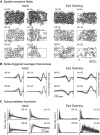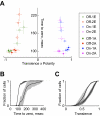Receptive field mosaics of retinal ganglion cells are established without visual experience
- PMID: 20107116
- PMCID: PMC2853272
- DOI: 10.1152/jn.00896.2009
Receptive field mosaics of retinal ganglion cells are established without visual experience
Abstract
A characteristic feature of adult retina is mosaic organization: a spatial arrangement of cells of each morphological and functional type that produces uniform sampling of visual space. How the mosaics of visual receptive fields emerge in the retina during development is not fully understood. Here we use a large-scale multielectrode array to determine the mosaic organization of retinal ganglion cells (RGCs) in rats around the time of eye opening and in the adult. At the time of eye opening, we were able to reliably distinguish two types of ON RGCs and two types of OFF RGCs in rat retina based on their light response and intrinsic firing properties. Although the light responses of individual cells were not yet mature at this age, each of the identified functional RGC types formed a receptive field mosaic, where the spacing of the receptive field centers and the overlap of the receptive field extents were similar to those observed in the retinas of adult rats. These findings suggest that, although the light response properties of RGCs may need vision to reach full maturity, extensive visual experience is not required for individual RGC types to form a regular sensory map of visual space.
Figures




References
-
- Akerman CJ, Smyth D, Thompson ID. Visual experience before eye-opening and the development of the retinogeniculate pathway. Neuron 36: 869–879, 2002 - PubMed
-
- Bansal A, Singer JH, Hwang BJ, Xu W, Beaudet A, Feller MB. Mice lacking specific nicotinic acetylcholine receptor subunits exhibit dramatically altered spontaneous activity patterns and reveal a limited role for retinal waves in forming ON and OFF circuits in the inner retina. J Neurosci 20: 7672–7681, 2000 - PMC - PubMed
-
- Bowe-Anders C, Miller RF, Dacheux R. Developmental characteristics of receptive organization in the isolated retina-eyecup of the rabbit. Brain Res 87: 61–65, 1975 - PubMed
-
- Carcieri SM, Jacobs AL, Nirenberg S. Classification of retinal ganglion cells: a statistical approach. J Neurophysiol 90: 1704–1713, 2003 - PubMed
Publication types
MeSH terms
Grants and funding
LinkOut - more resources
Full Text Sources
Medical
Miscellaneous

